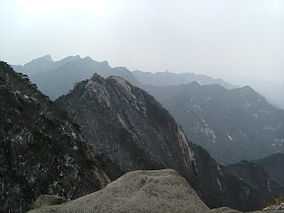
Back Taman Nasional Bukhansan BAN Bukhansangungnipgongwon CEB Bukhansan-Nationalpark German Parque nacional Bukhansan Spanish Parc national Bukhansan French 북한산국립공원 Korean Bukhan-san nasjonalpark NB Пукхансан (национальный парк) Russian Bukhansan nationalpark Swedish Pukxansan milliy bogʻi Uzbek
| Bukhansan National Park | |
|---|---|
| 북한산국립공원, 北漢山國立公園 | |
 Bukhansan National Park, from near the peak of Mt Baekundae. | |
| Location | Gyeonggi-do and Seoul, South Korea |
| Coordinates | 37°40′30″N 126°58′55″E / 37.675°N 126.982°E[1] |
| Area | 79.92 km2 (30.86 sq mi)[2] |
| Established | 2 April 1983 |
| Visitors | Around five million[2] |
| Governing body | Korea National Park Service |
| english | |
Land-based parks are in red and marine parks are in blue.
The Bukhansan National Park (Korean: 북한산국립공원; Hanja: 北漢山國立公園) in Seoul and Gyeonggi covers an area of 79.92 km2 (30.86 sq mi) and was established on 2 April 1983. Bukhansan means "mountains north of the Han River."
The park contains forested areas, temples and granite peaks. The three main peaks are Baekundae, 836.5 m (2,744 ft), Insubong, 810.5 m (2,659 ft) and Mangnyeongdae, 799.5 m (2,623 ft). Due to its popularity with hikers and Seoul residents, some trails are closed on a rotation basis to protect the local environment.
The Bukhansanseong Fortress is located in the park, together with its 9.5 km (5.9 mi) long defensive wall. A fortress was first built on this site in 132 AD to protect Seoul from foreign invasions, and it was expanded to its current size in 1711. It was reconstructed after damage sustained in the Korean War. Despite its name, this mountain is in Seoul, South Korea, so this mountain should not be confused with North Korea (also referred to as 북한, bukhan).
- ^ "Bukhansan National Park". protectedplanet.net. Archived from the original on 3 June 2012. Retrieved 22 September 2011.
- ^ a b "Bukhansan: Intro". Korea National Park Service. Archived from the original on 17 November 2015. Retrieved 18 September 2010.
© MMXXIII Rich X Search. We shall prevail. All rights reserved. Rich X Search
